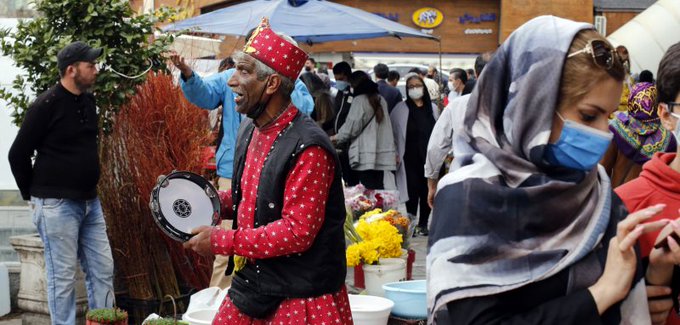IRANIANS HOPE FOR A NEW DAY

NEW DAY – NOWRUZ
Nowruz, the Persian New Year, took place on Saturday 20th March. It is the day of the vernal equinox and marks the beginning of spring in the Northern Hemisphere. Nowruz translates from Persian literally as New Day. In normal times it is a day of great celebration, where families come together to feast and greet the arrival of spring and the reawakening of nature at the start of a two-week holiday. There will be few celebrations and little feasting in Iran this year.
The beleaguered people of Iran must view the history of their country with wonder and puzzlement. They will learn how the world’s first human rights charter was inscribed under the direction of the Persian ruler Cyrus the Great more than 2,500 years ago. They will know how Shi’ites, Sunnis, Christians, Jews and people of all religions and none, lived in harmony in Persia, in a society where religion and the state were separate entities and where justice was fair and free from political influence. Sadly today, for eighty million Iranians, such a society does not exist. The mullahs’ ‘Velayat-e Faqih’ (absolute rule of the clergy), introduced when Ayatollah Ruhollah Khomeini hijacked the popular 1979 anti-monarchical revolution, offers only repression, cruelty, injustice, torture, corruption and the export of terror. That the mullahs do so in the name of Islam is an outrage and disgrace. Eighty million Iranians will have prayed this Nowruz for an end to decades of suffering under the tyrannical dictatorship of the theocratic fascists.
The Iranian economy is broken. Inflation and spiralling prices have forced millions to search through garbage bags and bins for scraps of edible food. Many now cannot even afford to buy bread. For the past nine weeks, pensioners have braved the Covid-19 pandemic to take to the streets in towns and cities across Iran to demand help from the government. Instead of help they have encountered a brutal crackdown from the Islamic Revolutionary Guards Corps (IRGC), the regime’s Gestapo. Javad Esmail-Nia, the Friday Prayer Leader in Bandar-e Lengeh, a coastal town in southern Iran, said before Nowruz: “On the eve of the New Year, skyrocketing prices have broken the backs of the poor. An Iranian citizen is only able to purchase one kilogram of fruit with the monthly subsidy.”
Due to the regime’s venal corruption and toxic economic policies, Iranians are facing mass unemployment and grinding deprivation. Those who have a job are receiving 2.5 to 3 million tomans ($6 to $7) daily. In comparison, the average cost of a food basket for a family of four has reached 8 to 9 million tomans ($19-$21). Meanwhile the mullahs continue to pour cash and resources into Bashar al-Assad’s bloody civil war in Syria, now in its tenth year. Heshmatullah Felahatpisheh, the former Chairman of the National Security and Foreign Policy Commission of the Iranian parliament, recently claimed that he knew the regime had paid Syria up to $30 billion. They have also sent billions to the terrorist Hezbollah in Lebanon, the Houthi rebels in Yemen and the brutal Shi’ia militias in Iraq. The regime’s economic policies have devastated Iran’s financial structure and brought the country to its knees.
There have been repeated uprisings in recent years, as ordinary Iranians express their scorn for the theocratic regime. The latest protests in the border province of Sistan and Baluchistan saw 40 people murdered and hundreds critically injured by the IRGC. But this was only the most current of three nationwide uprisings. The mullahs are hated and Iran has become a trembling volcano, ready to erupt. Hunger leads to revolution. When the people are starving in the streets, there is political unrest that can quickly turn ugly. The mullahs’ knee-jerk reaction is to order the IRGC to shoot to kill. They shot dead over 1,500 young men and women in the nationwide protests of late 2019. Thousands more were wounded and dragged off to prison from their hospital beds. Many have since been tortured and executed. The mullahs’ reaction has only increased the people’s hatred toward the regime, to the point where even the clerics themselves are afraid. Last week one of the regime’s most senior clerics, Fazel Meibodie, said: “Hungry people can no longer be suppressed. It is possible to control the situation with repression in the short term. Still, it is no longer possible to control this situation with repression in the long run. In simple words, the regime sows the wind and will reap the whirlwind.”
Now, resistance units of the People’s Mojahedin of Iran/Mojahedin-e Khalq (PMOI/MEK) have taken root in towns and cities across Iran. Courageous freedom fighters now regularly stick up posters and banners and splash graffiti on public walls and buildings, showing their support for the charismatic president-elect of the National Council of Resistance of Iran (NCRI), Mrs Maryam Rajavi. They know that they will face certain torture and execution if they are caught. IRGC offices and police stations have been firebombed as the people increasingly lose their fear. The Iranian people also look to the West for support. They do not want to see military intervention by the Americans. They know how that ended badly for neighbouring Iraq. But they do want moral support for their own right to overthrow the mullah’s fascist dictatorship. The last thing they want is for President Biden to mark Nowruz by lifting sanctions and restoring the deeply flawed nuclear deal. The Iranian people recognise that the regime is at its weakest point ever and will collapse if the West continue to withhold assistance. Regime change will allow freedom, democracy, justice, human rights, women’s rights and a nuclear free Iran to be restored. Nowruz will then really witness the beginning of a New Day for Iran.
